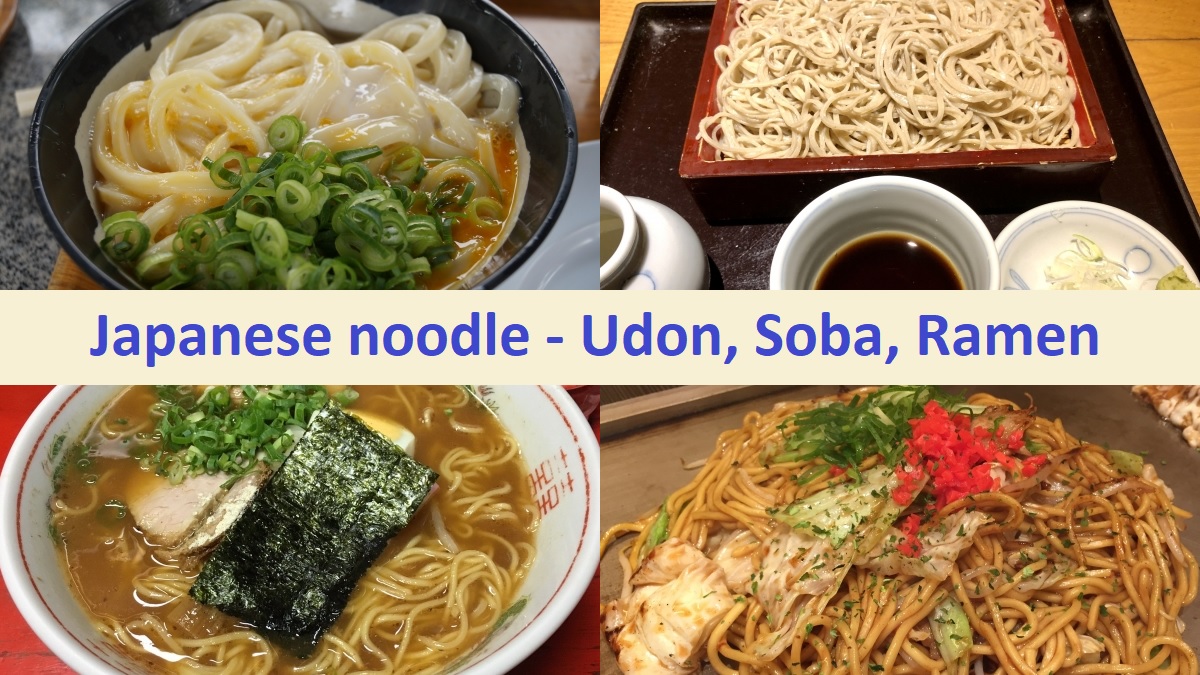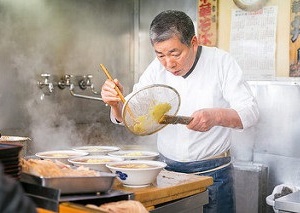Japanese noodle - Udon, Soba, Ramen
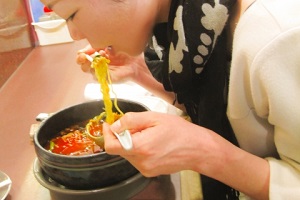
Japanese people like noodles very much.
Noodle is eaten as light meal, and we can easily find noodle restaurant.
Additionally, there are many stand-up-eating shops of noodle in the center of the cities or near the railway stations.
Busy people visit there and have a meal quickly.
Most popular noodles are Udon, Soba and Ramen.
Needless to say, you must eat any Japanese noodle with chopsticks.
(No fork is prepared.)
And, a spoon is supplied to eat the soup in many restaurant.
Of course, use it.
In addition, it is OK to drink the soup from the bowl directly.
If there is no spoon, do so.
Udon and Soba
About udon and soba
Udon is a noodle made of plain wheat flour.
It is white noodle like spaghetti, but it is thicker and softer than spaghetti.
Soba is a noodle made of buckwheat flour.
It is gray noodle and the thickness is about 1.5 to 2 milimeters.
It is harder than udon.
We can eat both noodle everywhere in Japan.
Most noodle restaurants serve both, but there are some restaurants of only udon or only soba.
Generally, udon tends to be liked in western Japan, and soba tends to be liked in eastern Japan.
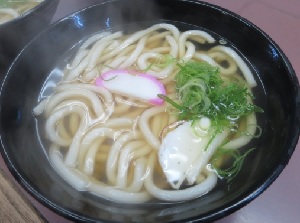
Kake-udon
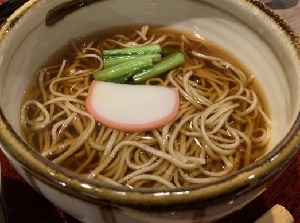
Kake-soba
About udon, Sanuki-udon is the most famous brand.
It is made in Kagawa prefecture in Shikoku island, and the old name of the area is Sanuki.
About soba, many areas have the brand.
A famous soba is Shinshu-soba, and it is the soba made in Nagano area.
Cooking of udon and soba
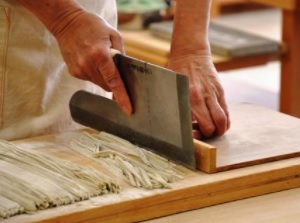
Making Soba noodle
You can choose hot or cold cooking of these noodles.
Hot udon/soba is made by boiling the noodle, filling a bowl with hot soup mixed with dashi, shoyu and mirin, and putting the boiled noodle into the bowl.
It is usually topped with thinly chopped green onion.
You can season it with some powder of red pepper according to taste.
Basic hot udon/soba with few toppings is called Kake-udon/soba.
(In general, the soup broth is thick in eastern Japan including Tokyo and is based on light-colored and tasty dashi in western Japan including Osaka, Kyoto.)
Cold udon/soba is made by boiling the noodle and cooling the boiled noodle swiftly in water.
The cold noodle is often served on a sieve-like bamboo tray called "zaru".
It is called Zaru-udon/soba.
Chopped dried nori are commonly put on Zaru-udon/soba.
And simple cold udon/soba without dried nori is called Mori-udon/soba.
A cup of cold soup mixed with dashi, shoyu and mirin is served.
You pick up a mouthful amount of noodle with chopsticks and dip it in the soup.
Soon, you eat the noodle picking up the soup.
Usually thinly chopped green onion is added as a condiment and grated wasabi is mixed as a spice into the soup.
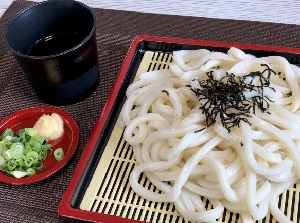
Zaru-udon
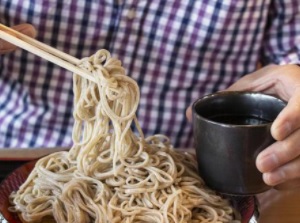
Mori-soba
By the way, you may have no experience of eating cold noodle.
Because Japan is very hot in summer, Japanese people enjoy the cold noodle in such season.
Especially cold soba is liked by many people in all seasons.
Variety of udon and soba
Hot udon/soba is able to top with various foods.
If a piece of abura-age is topped, it is Kitsune-udon/soba. (In English "kitsune" means fox.)
If a raw egg is topped, it is Tsukimi-udon/soba. ("Tsukimi" means moon viewing.)
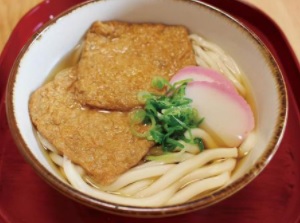
Kitsune-udon
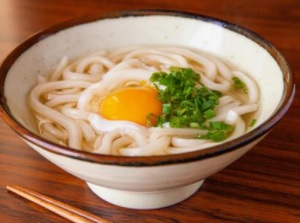
Tsukimi-udon
If a few pieces of tenpura are topped, it is Tenpura-udon/soba.
Especially, a round tenpura mixed with chopped vegetables is called "Kakiage", and the udon/soba of kakiage is called as Kakiage-udon/soba.
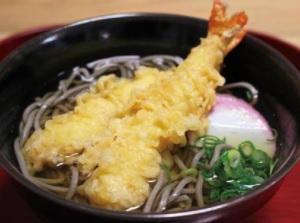
Tenpura-soba
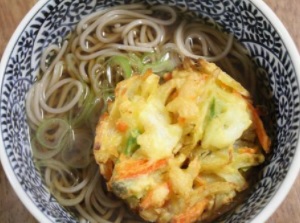
Kakiage-soba
And there is unique Curry-udon.
It is a hot udon with the curry soup, and the base of the soup is Japanese taste.
Of course, we can find many other varieties of udon/soba in any noodle restaurant.
Cold udon/soba have also a variety.
There is the cold udon/soba served on a bowl.
In this case, you pour the served cold soup on the noodle before eating.
It is called Bukkake-udon/soba, and generally various foods are topped on the noodle.
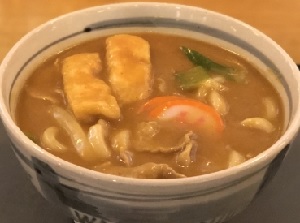
Curry-udon
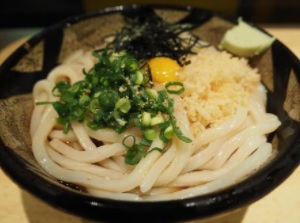
Bukkake-udon
Ramen
About ramen
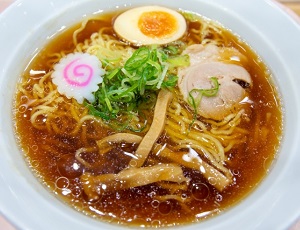
Ramen is a very popular with whole generations.
Ramen is originally a Chinese noodle.
Therefore, it is very different from udon or soba in taste and cooking.
It has caught on in whole Japan rapidly in the late 20th century, and has been a sophisticated noodle menu.
Chinese cuisine has also noodle dish.
But Ramen is a Japanese dish developing in Japan.
Cooking of ramen
Basically, ramen is hot menu.
The noodle is made of plain flour.
But, because special alkali water is used, the color of noodle is yellow.
This is the feature of Chinese noodle.
Ramen is made by boiling the noodle, filling a bowl with hot ramen soup and putting the boiled noodle into the bowl.
Ramen soup is very different from traditional Japanese soup.
Basic soup is made by boiling chicken bone, pig bone, dried fish, green onion and other many vegetables, a few fruits and spices in water for several hours.
So it becomes very richly-textured clear soup.
This is the normal basic soup.
But, there is another distinct soup.
It is made from only pig bone and is white and thick soup.
It is called "tonkotsu soup", and it forms a major category of Ramen soup.
Each ramen restaurant makes unique basic soup and expresses its individuality.
Ramen soup for the customer is accomplished with adding a main flavor.
When you order a ramen at a restaurant, you can choose among a few flavors.
Generally, they serve "Shoyu" (soy sauce), "Shio" (salt) and "Miso".
Some ramen restaurant serve "Butter" adding to these flavors.
Finally, some foods are topping.
Standard foods are some slices of barbecued pork, pickles of Chinese bamboo shoot and thin-chopped green onion.
Sometimes, boiled egg, nori, boiled spinach, fried vegetables and so on are topped on the Ramen.
Major Ramen cities
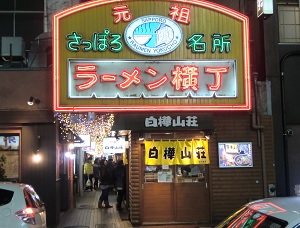
Ramen Yokocho in Sapporo city (Street of Ramen shops)
Ramen is very popular noodle in Japan, so we can eat it in all areas.
But, several cities have created the ramen with regional characteristics.
First, I introduce the three major Ramen in Japan.
- Sapporo Ramen : Sapporo city in Hokkaido.
Soup is the base of tonkotsu. Wavy noodle is used.
Soybean sprouts and sliced onion fried with lard are topped. - Kitakata Ramen : Kitakata city in Fukushima Prefecture.
Soup of pork bone is clear and the flavor is the base of shoyu.
A little wavy noodle is used. - Hakata Ramen : Fukuoka city in Kyushu.
Soup is very thick tonkotsu. Straight thin noodle is used.
Only a few toppings are added.
And the followings are known as the popular Ramen city.
- Hokkaido : Asahikawa, Hakodate
- Tohoku Region : Shirakawa
- Kanto Region : Tokyo, Sano
- Tokai Region : Takayama
- Kansai Region : Kyoto, Wakayama
- Chugoku Region : Onomichi
- Shikoku : Tokushima
- Kyushu : Kurume, Kumamoto, Kagoshima
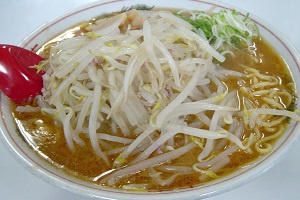
Sapporo Ramen
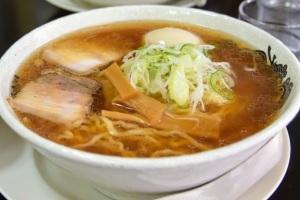
Kitakata Ramen
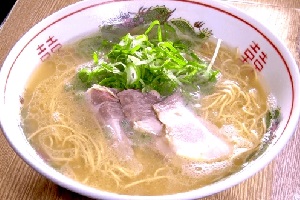
Hakata Ramen
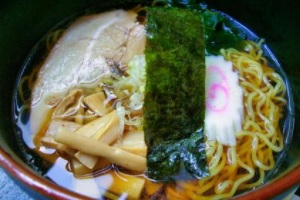
Tokyo Ramen
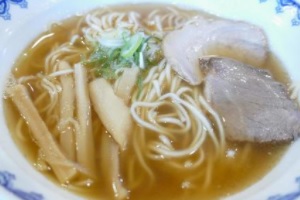
Takayama Ramen
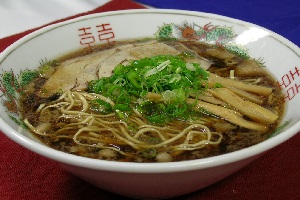
Onomichi Ramen
Other noodles
Somen
Somen is very thin noodle like kite string.
It is made of plain flour, and we generally eat like cold udon.
The cold and thin noodle slide down our throat, so we sometimes enjoy eating in summer.
Kishimen
Kishimen is flat udon with 5 to 10 milimeters width.
It is made only around Nagoya area, so it is one of specialities of Nagoya.
We can eat it like udon.
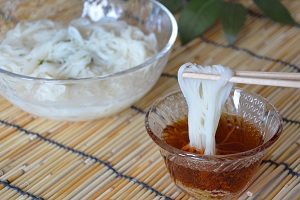
Somen
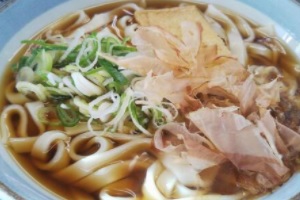
Kishimen
Hiyashi-Chuka
Hiyashi-chuka means "cold Chinese noodle".
It is made by cooling the boiled ramen noodle in water and putting the soup based on vinegar and shoyu on the noodle.
Chopped cucumber, sliced tomato, chopped fried egg and other ingredients are topped. So it looks like salad.
Commonly this is served in summer.
Yakisoba
Yakisoba means fried soba.
But it is used not soba but Chinese noodle.
It is made by frying Chinese noodle on a hot plate and seasoning it with Worcestershire sauce.
We can't find this menu at most restaurants.
Rather, it is made at home.
It is sold in supermarket and convenience store.
And, we can also find some stands at main festival of temple or shrine.
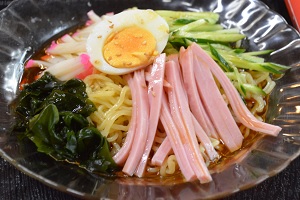
Hiyashi-Chuka
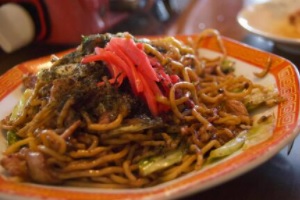
Yakisoba
Nikomi-udon
In an earthen pot with lid, udon and various ingredients are boiled with Japanese soup.
In other words, it is often called as Nabeyaki-udon.
It is very hot, so it is mainly served in winter.
In Nagoya area, thick miso is mixed in the soup.
It is called as "Miso Nikomi-udon", and is the speciality of Nagoya.
In Yamanashi area, rough and wide noodle and vegetables are boiled in the miso soup.
It is called as "Houtou", and is the speciality of Yamanashi area.
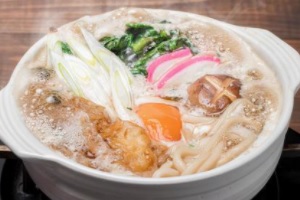
Nabeyaki-udon
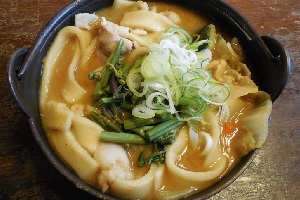
Houtou in Yamanashi area
Loud slurping noises is OK
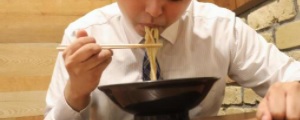
When you eat at any noodle restaurant, you may hear the noise that some people eat noodles with making loud slurping noises.
But they are not mannarless.
In Japan, when eating noodles, slurping noises is OK.
It is a Japanese tradition since more than 300 years.
I hear that some foreign tourists criticize the manner.
But, it is a culture rooted in Japan, and I think it beside the point to say "in Japan".
(Most Japanese people know they should eat noodles without noise in the other country.)

